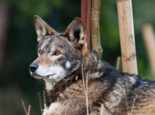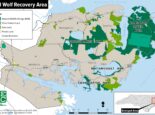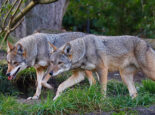The world’s only wild red wolves are in jeopardy
The South is home to the world’s only wild red wolves
North Carolina is home to the only wild population of red wolves in the world. Historically, the red wolf ranged across the entire Southeast, but today, the only place in the entire world where wild red wolves can be found is in eastern North Carolina’s Albemarle Peninsula. Even there, they number only over a dozen known red wolves. That’s down more than 80 percent from the wild population of red wolves a decade ago, when an estimated 100 red wolves lived within the same five-county area. Smaller than their gray wolf cousins, America’s red wolf is now classified as “critically endangered”—one of the most endangered canids in the world.
What methods have kept red wolves from going extinct?
Years of hunting and habitat loss drove the species to the brink of extinction by the 1970s, when the U.S. Fish and Wildlife Service gathered 14 of the remaining wild red wolves and launched a successful captive breeding program. In 1987, USFWS began reintroducing red wolves back into the wild in eastern North Carolina, and by the early 2000s the wild population had grown to approximately 100 animals. Growing and maintaining that healthy population required USFWS to regularly place captive-born red wolf pups into wild dens through a process called “pup fostering” and to implement an adaptive management program reducing hybridization between red wolves and coyotes. These conservation efforts are proven: releasing captive wolves helped the wild population grow from four pairs to nearly 130 animals. Yet for several years, USFWS abandoned protections for red wolves and we went to court to get red wolf conservation back on track. Our efforts led to a historic settlement in 2023 renewing critical red wolf conservation efforts.
We hope to see America’s wild red wolves rebound again, with generations born free and wild, as a result of this agreement.
Ramona McGee, Senior Attorney and Leader of SELC’s Wildlife Program
SELC’s work to save red wolves
SELC has been vigilant in fighting USFWS’s anti-conservation policies that rejected science-based thinking. In 2014, the agency allowed private landowners to shoot and kill non-problem red wolves, simultaneously suspending conservation measures that had included releasing captive wolves into the wild and managing coyotes in the federal Red Wolf Recovery Area. SELC sued, successfully putting an end to the authorization of killing or removal of non-problem red wolves, and we sued again in 2020 after USFWS adopted a policy barring the release of captive-born red wolves into the wild. The law doesn’t allow USFWS to walk away from wildlife conservation. After we won a recent federal court ruling, we welcomed the fostering of captive red wolf pups with wild parents, and releases of captive adult wolves into the wild. Notably in 2022, the first red wolf pups were born in the wild since 2018. In 2023, more wild pups were born in the spring, and the fall brought the historic settlement that recommits USFWS to necessary conservation measures. SELC remains committed to getting the critically endangered red wolf a chance at survival.



